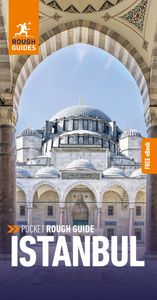Amasra
AMASRA brazenly flaunts its charms to new arrivals. Approached from any direction, the town suddenly appears below you, swarming up onto a rocky headland sheltering two bays. A narrow stone bridge links the main town to the island of Boztepe further out, while the headland shelters the east-facing Büyük Liman (Big Harbour) on one side and the west-facing Küçük Liman (Little Harbour) on the other. As the beaches at both are at best average, it’s best to regard Amasra as a base for forays to better beaches further east.
Amasra’s historical pedigree and colourful atmosphere make it worth at least an overnight stop. During the day it is a quiet place, full of shady corners to sit and contemplate. By night it’s much livelier, and the old walls are lit up attractively, but it doesn’t lose its small-town charm.
Brief history
Mentioned as Sesamus in the Iliad, Amasra was colonized by Miletus in the sixth century BC. The name derived from Queen Amastris, a lady of the court of Alexander the Great, who, after the death of her husband, acted as regent for her young son, only to be repaid with murder at his hands. Avid letter-writer Pliny the Younger was appointed Rome’s special commissioner to this region in 110 AD. After the ninth century, following a barbarian attack, the town declined in importance, though the Byzantines maintained a garrison here. The Genoese took over when Byzantine strength declined, and held the city until the Ottomans assumed control in 1460.
Samsun
Despite its long and turbulent history, SAMSUN has few remaining historical or scenic attractions, and even its tourist office now lies defunct. A thoroughly modern city with a population knocking on one million, it’s laid out on a grid plan, with endless unruly suburbs stretching 30km along the east–west coast road. It’s a busy port and centre for the processing of local agricultural produce and tobacco.
Because of its strategic location, Samsun changed hands frequently over the centuries. It was besieged, captured (and usually sacked) by the Pontic kings, Romans, Byzantines, several tribes of Turks and the Genoese, who had a major trading station here until 1425, when they torched the town rather than hand it over to Ottoman control. When the advent of the railway facilitated the transport of tobacco to Ankara and beyond, Samsun’s flagging fortunes revived, and by 1910 it was a thriving city of 40,000 inhabitants. The port city gained a place in Turkish folklore when then Mustafa Kemal, under the guise of “Inspector General of the Ottoman forces in Anatolia”, arrived in 1919 by steamship from İstanbul and quietly began to sow the seeds of independence among the local Turk population.
Nowadays, any spare time in Samsun may well weigh heavy on a traveller’s hands, but it holds a couple of hours’ worth of interesting sights, plus a fair amount to offer in terms of food and lodgings should you need to spend the night. The main square in the city centre, Cumhuriyet Meydanı, boasts a statue of Atatürk on horseback. Kazımpaşa Caddesi and Cumhuriyet Caddesi run north and south of the square respectively, while 19 Mayis Bulvarı, which runs both east and west, meets Fuar Caddesi, the main coastal road, at its far eastern end.
Sinop
Straddling a beach-studded isthmus, and blessed with the finest natural harbour on the Black Sea, sleepy SİNOP is renowned as one of the prettiest towns along the coast. A fine clutch of monuments bestows a real authority on the place, even if most visitors are content to relax along the café-lined harbour-front, where bobbing boats supply the day’s catch to the line of restaurants behind.
As the northernmost point of Anatolia, less than two hundred nautical miles from the Crimea, Sinop played a front-line role during the Cold War, when it was the location of a US-run listening post. These days fishing and tourism provide most of the income for its 35,000 inhabitants, who are currently fighting proposals to build a nuclear power station nearby.
Although time has inevitably taken its toll, Sinop’s prominent city walls remain by far its most compelling feature. Opposite the old fortress and prison, the bulky Kumkapı juts out bastion-like into the sea on the northern shore, while down near the harbour a hefty square tower offers good views out to sea, and strolls along the nearby sections of wall.
Brief history
Sinop takes its name from the mythical Amazon queen Sinope. The daughter of a minor river-god, she attracted the attention of Zeus, who promised her anything she desired in return for her favours. Her request was for eternal virginity; Zeus played the gentleman and complied.
After a wealthy period of Roman rule, Sinop declined during the Byzantine era, while Persian and Arab raids thwarted sixth- and seventh-century attempts to revive its fortunes. The Selçuks took the town in 1214, converting churches into mosques and erecting a medrese, but after the Mongols smashed their short-lived state, Sinop passed into the hands of the İsfendiyaroğlu emirs of Kastamonu until Ottoman annexation in 1458. Thereafter the town was rarely heard of, except on November 30, 1853, when the Russians destroyed both Sinop and an Ottoman fleet anchored here, thus triggering the Crimean War, and again on May 18, 1919, when Atatürk passed through en route to Samsun.






















